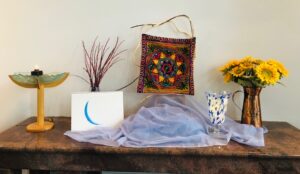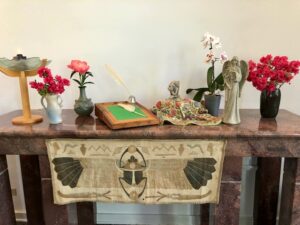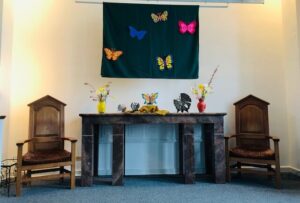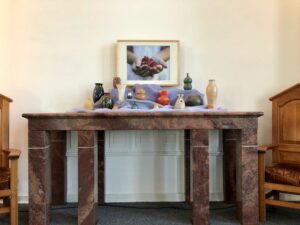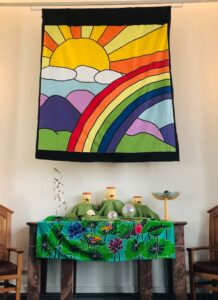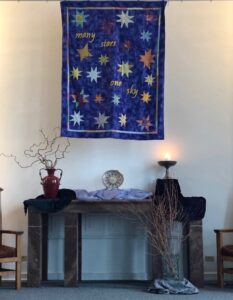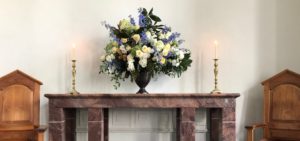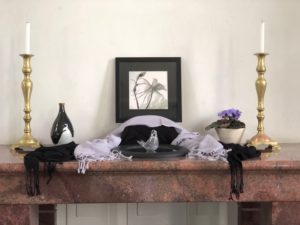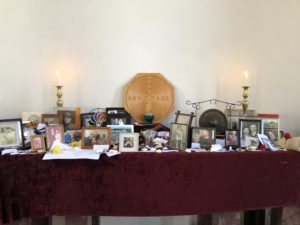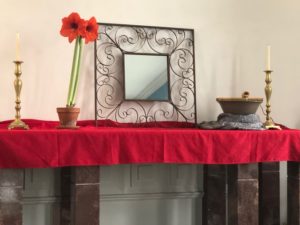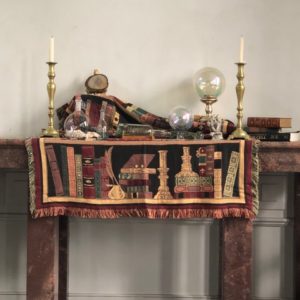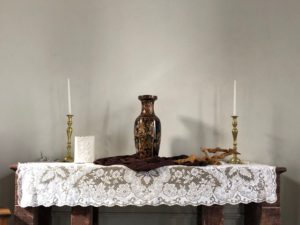This service was part of the second UU White Supremacy Teach-In, which encouraged (and challenged) UU congregations around the country to look intentionally and explicitly at the ways we all participate in white supremacy culture.
Peter Walpole contributed an original piece for the Opening Words, “Three Fifths Compromise.”
I’m want you to hang on to two numbers – 700 and 200 – because I think that they point to one of the reasons our Association of Congregations is having this second “white supremacy teach-in.” 700 and 200. Okay? Okay.
My friend Aisha Hauser is one of the three powerful and prophetic leaders of color who have called the congregations in our Association to look with unflinching honesty at the ways our Association, our congregations, and we as individual Unitarian Universalists participate in and perpetuate the systems and structures of white supremacy culture. (One of the others is Christina Rivera, our Director of Administration and Finance, who, along with Aisha, and Kenny Wiley, and with the help of a lot of other people, volunteered their time and talents outside of and on top of their “day jobs,” because they love our movement so deeply and fiercely.)
In describing this work, Aisha has said:
The UU White Supremacy Teach In is an effort to help us, well-meaning liberals, learn our complicity in a system that favors whiteness and punishes black and brownness.
I have been asked, “Why use these words? [White Supremacy] Why not different words?”Kind words, gentle words, flowery words, poetic words, all manner of words have been used for the past four hundred years trying to explain the pain and suffering of black and brown people at the hands of white people and none have resulted in liberation.
It is past time to use words that are true and accurate and yes painful. It was painful for me to realize my complicity in a white supremacist system. And I realized that I must bear witness to what I notice and recognize, especially when it is in my beloved chosen faith.
I know this is uncomfortable. […]
This … is … uncomfortable. For some of us, it is a whole lot more than simply “uncomfortable,” while for others it is something entirely different than “uncomfortable” – it’s inaccurate, off-putting, a bad strategy, or deeply, deeply offensive. For still others of us – most often those of us who identify as people of color – it is both long overdue and painfully frustrating that we have to do it at all, and that some of us – most often people who identify as white – are so resistant to it.
Philosophers often begin their papers by defining their terms so as to be able to sidestep arguments over language and focus on the real issues. The reader, then, is expected to say, “Okay, that’s not how I understand that term, but if that’s how she’s using that word, what do I think of the point she’s trying to make with it?”
So here’s the way I’m using these words this morning. (And it’s not just me, and it’s not just some radical Unitarian Universalists. Academics who study race and racism in our country, and activists who are working to change things are using these words in this way too.)
“White Supremacy Culture” refers to the dominant culture in our society which is intended to foster and perpetuate the oppression of people of color, and to elevate everything “white” to a superior, to a supreme, position: history focused on the actions of white people; music and literature reflecting white tastes and norms; the designation of some language as “proper,” and what is in some way or other “deviant;” social norms of dress, and hair, and preferred features and body types; who is a bankable lead in a movie. I could go on with more specifics, but the point is that white supremacy culture is fundamental – foundational – to our society, and as such every institution incorporates, and is built upon, its systems and structures to some extent.
The term “white supremacist” is a little trickier, a little more nuanced. There are obvious and explicit white supremacists like Richard Spencer and his ilk. At the same time, though, virtually every individual is at least deeply influenced by the rot of white supremacy culture, even if unconsciously and unwittingly … even people who are consciously and intentionally working to combat it. We are, some have said, like fish who are entirely unaware of the water in which we swim because it is so pervasive. We are – even well-meaning liberal-minded white folks like most of us here – in this sense “white supremacists,” because the culture of white supremacy has perniciously permeated our thinking, our perceptions, and our behavior at our very core … even if, again, unconsciously and unwittingly.
You may disagree with the way I have said I am using those words, but for this morning I’d ask that you set that disagreement aside, and try to be open to what I’m trying to say with them. It should go without saying, I hope – although I’m going to say it anyway – that I am more than happy to talk with anyone who would, later, like to tell me what those words mean to them. I have not been called here to dictate to you what you should think but, rather, to share what I think as clearly, and lovingly, and forthrightly as I can so as to challenge you to really consider what it is that you think and believe. But for our relationship, for our mutual ministries, to have any meaning, I have to be open to being challenged as well … just as open to being changed by our interactions, just as open to being changed, as our faith calls you to be. For ours is not a church of the “closed and unchanging mind.” Each week our children remind themselves in Children’s Chapel that our is “a church of open mind.” That’s something those of us who gather here, instead of there, would do well to remember … at least from time to time.
Given the events that took place here this summer, and that Spencer’s in-and-out 10-minute rally a few weeks ago assured us that they will continue, it is all too clear that conscious, intentional, and disgustingly explicit white supremacists have not gone away in our country and that they are being emboldened. When the man who occupies the Oval Office does not plainly, forcefully, and unambiguously denounce them, he gives them his tacit approval.
Yet we were shocked when all those voices of hate descended on our beautiful oasis of progressivism, and we are disbelieving in the face of all the anger and all the charges of complicity that have been directed toward our police and city officials. We can’t believe the things that have propelled us into the national spotlight, that have made of our city a symbol for late-night talk show monologues and political posturing. We’re saddened by all of the pain, and the brokenness, and we really want to see the anger give way to healing. And I know that some of us are thinking this morning that given that we have had actual torch bearing mobs in our city, the idea that we’re being asked – in the safety of our own sanctuary – to look at our own participation in, and even perpetuation of, white supremacy is insulting. Right?
First, my apologies to the people of color here (and those who may eventually read or listen to this sermon online). You’ve just had to sit through the talk of yet another white person who clearly doesn’t get it. I know that you’ve had this experience far too often, nearly everywhere you go, even in the so-called “safety” of sanctuaries like this, and I am sorry to have put you through that again in order to make a point.
Now, for those of us who identify as white – did you notice what it is I’m apologizing for? I wouldn’t have just a few years ago. I can look back over two decades of sermons, and I did it over and over again with absolutely no awareness that I was doing it. The “it” that I was doing is participating in and perpetuating the systems and structures of white supremacy culture. Nothing less.
Throughout that paragraph about our experiences of, and responses to, the events that took place here this summer I kept saying “we” and “our.” But that “we” and “our” were not as inclusive as … well … “we” might have thought. That “we” was, really, a white “we,” because it ignored the experiences of, and responses to, the events that took place here this summer from the perspective of people of color, which are often really quite different.
While it’s not uncommon for those of us who identify as white to have been shocked and surprised by the ugliness of the Klan and the alt-right, it is perhaps equally uncommon for those of us who identify as people of color to not have been. And to say that this ugliness came to our city from outside, as though it weren’t already here, is something that it is far more likely for a white person to say. That’s because we – we white people – don’t have to live with it every day. Don’t have to expect it. Don’t have to brace for it. Don’t have to take notice of it, even, because it is not our day-to-day, lived experience. Most of us didn’t even notice that I was lifting up our white experiences and perceptions as though they were universal, oblivious to the fact that I was excluding people of color from that “we.” That’s a small demonstration of the way even we liberal-minded, good-hearted white folks keep the systems and structures of white supremacy culture alive. And we do so often, in so many ways, with absolutely no consciousness of doing it.
I’m speaking in some generalities, of course – there were people of color who were shocked and white people who weren’t – but in general, as a rule, it is simply the truth that people who identify as white and people who identify as people of color very, very often experience things in very different ways. Yet those of us who identify as white often, without thinking, identify our perceptions and experiences as normative, as though we speak for all. (One of my favorite sayings about white supremacy and white privilege is that those of us who identify as white “get to define reality and have our definition stick.”)
This may seem unimportant when there are people with Confederate battle flags, and Nazi flags, and Ku Klux Klan robes marching in the streets. And it’s true that those alt-right folks are perhaps the most explicit manifestations of white supremacy culture. Yet when I, even unconsciously, do something like lift up my white experience as if it is the experience, I essentially ignore, dismiss the realities of people of color. I dismiss them. And I demonstrate that white supremacy is alive and well here, too. And that make this sanctuary less safe for those who are not included in my “we.” It’s perhaps a difference of scale, but certainly not of kind. And that matters.
The reason we’re engaging in this white supremacy teach-in this morning is that those of us who identify as white need to learn to be more aware of the ways we participate in and perpetuate white supremacy culture, and because those of us who identify as people of color need to see that our Association, our congregations, and individual UUs are taking this seriously. And we’re not just trying to take this seriously here in our sanctuary:
Today our religious education programming is focusing on issues of white supremacy in age appropriate ways, and they don’t do this just once or twice a year, but have an intentional racial justice focus on one Sunday each month.
Our Adult Faith Development programming consists largely of curricula that aim to help our white members become more aware, and all of our members to find ways to make a difference in this struggle for our mutual liberation.
This past week our Board was talking about the importance of doing its own work in unlearning the lessons of white supremacy, looking for the ways it is embedded in our systems and structures, and leading our congregation toward being that “powerhouse for racial justice” so many of us desire to be.
We have a strong Racial Justice Committee which meets monthly. Its Chair, Kate Fraeligh, sends out an email each week which lists events in the community that you are encouraged to participate in.
And following [our second/this] service, in addition to the congregational potluck, there will be a “Race Café,” which is to be a space in which people can talk about any or all of this in an informal, yet safe way.
The reason that we have been encouraged to hold a second UU White Supremacy Teach-In, even though we engaged in one just this past May, is that it is so easy for those of us who identify as white to get all riled up, all charged up, all energized by the work of dismantling white supremacy culture … and then find our focus moving on to something else. It is so easy for us – that us – to forget realities that are not our own day-to-day realities, and, so, to forget the urgency of confronting and combating systems and structure that poison all of us (even those of us who aren’t aware of it).
Do you remember those numbers? 700? 200? Back in May, more than 700 Unitarian Universalist congregations participated in that first White Supremacy Teach-In. That’s roughly 70% of all Unitarian Universalist congregations in our Association, and I have never experienced that kind of a response anything. This time, though, there are only a little more than 200 congregations that have committed to taking time to intentionally examine and engage with these issues. 700 down to 200. 70% down to 20%. That’s a pretty dramatic decrease over a time during which there has been an extraordinary increase of undeniable demonstrations of just how present and real and dangerous white supremacy is … for all of us.
This is uncomfortable, yes … and it is so very necessary. And until we can honestly say that we have overcome, and until our “we” truly includes us all, and until we’ve built that “new way” that we need in order for the Beloved Community to be established and deeply rooted, then we – all of us “we” – will need to stay in this uncomfortable place, and stay with this so very necessary work. We are called to nothing less.
May it be so.
Pax tecum,
RevWik

